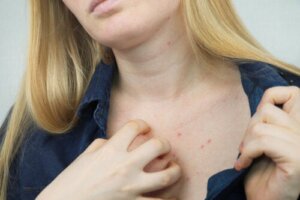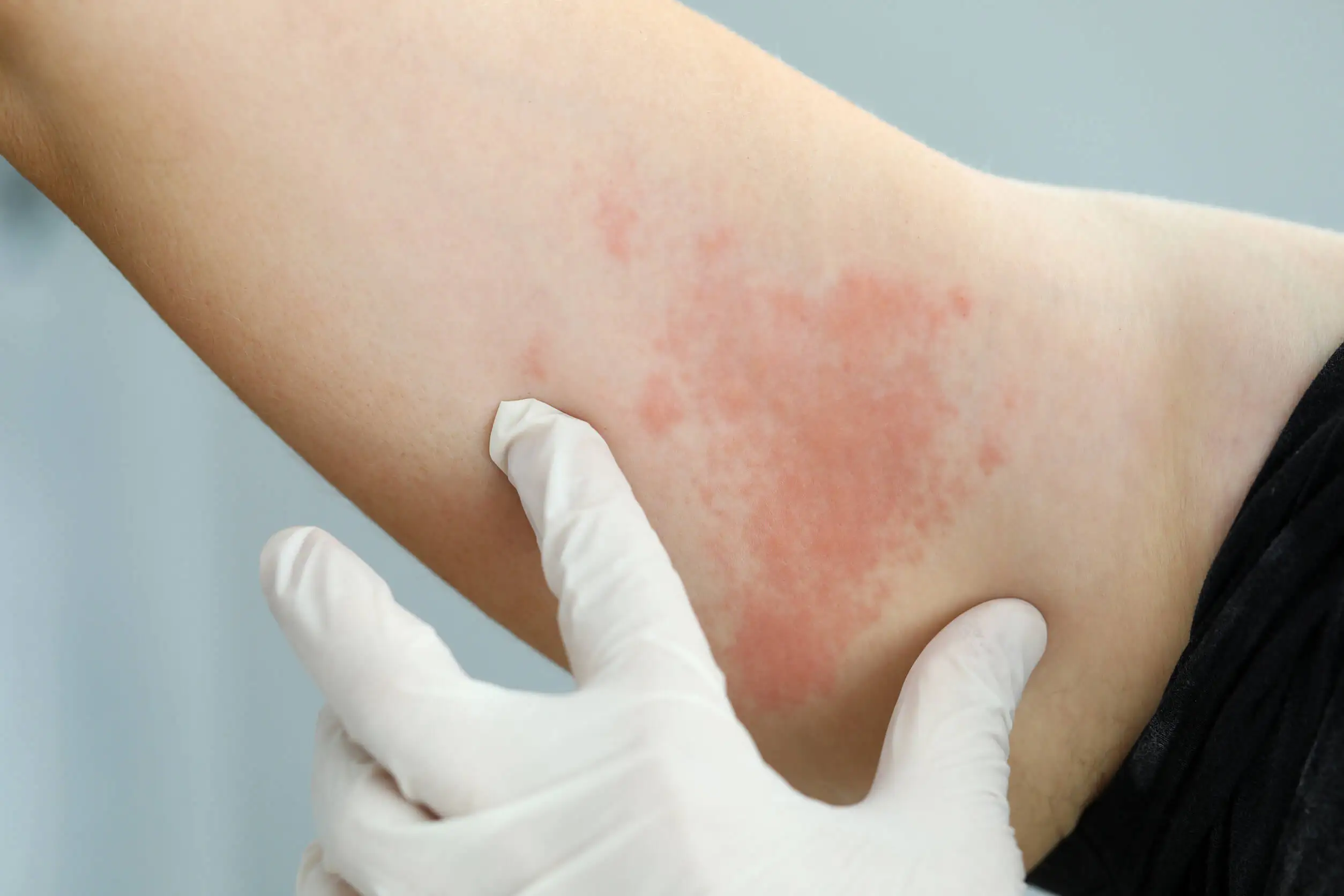What Are the Most Frequent Adverse Reactions to Cosmetics?

Some substances that come into contact with your skin, such as cosmetics, can cause a negative reaction. Many different factors can trigger these skin reactions, often caused by allergies and causing inflammation, which can sometimes even require medical intervention. Find out about these adverse reactions to cosmetics in this article.
Intolerance to ingredients in makeup or personal care products can put your health at risk if you treat them incorrectly. Find out what these skin disorders consist of and the proper way to deal with them.
What are adverse reactions to cosmetics?

Cosmetics are products used on the human body for cleansing, beauty or to alter the external appearance without impairing the functioning or structure of the body. The definition covers products such as:
- Creams
- Lotions
- Soaps
- Makeup
- Perfumes
- Deodorants
- Sun protection products
Most people should naturally tolerate cosmetics. However, resistance to certain components is possible. This occurs due to skin pathology or irritation.
While many personal care and beauty products are safe, you can’t rule out that some products could cause adverse reactions. The physical symptoms are usually evident on the skin, although sometimes the discomfort is internal.
Adverse reactions occur when the product is used as directed by the manufacturer, not from misapplication.
Common cosmetic ingredients that cause adverse reactions
Flavored, no-rinse toiletries increase the risk of side effects. For example, moisturizers, bleaches, hair dyes, nail polishes, and makeup sponges or applicators are items that are highly likely to affect us adversely.
The danger arises because they’re manufactured with chemicals such as benzyl, propylene glycol, and lanolin. They also contain active ingredients such as hydroquinone and additives such as formaldehyde.
A text in the journal Actas Dermo-Sifilográficas points out that every ingredient is considered a potential sensitizer. However, there are 3 particular compounds that increase the risk.
- Preservatives. These are active biological mixtures whose exclusive purpose is to inhibit the development of microorganisms in cosmetics.
- Allergens. These are fragrances that, when they bind with a skin protein, can create phenomena in the immune system, according to the European Commission’s Scientific Committee on Consumer Safety (click on the appropriate tab to see information in English).
- Irritants. These are used to treat acne, photoaging, and hyperpigmentation. The reaction varies according to exposure time, concentration, and depth of penetration.
Another great article: What You Should Know About Parabens in Cosmetics
What are the most common adverse reactions to cosmetics?
The Official Journal of the European Union published Regulation (EC) No. 1223/2009 on cosmetic products, highlighting that there are 2 types of adverse reactions. The first are undesirable effects on human health, attributable to the normal use of the substance.
The second are serious undesirable effects, leading to functional or permanent incapacity, disability, hospitalization, congenital anomalies, and immediate risk to life. Concentrations above the permitted concentrations tend to produce responses such as the following.
Sensitive skin
Anyone can experience side effects, but people with sensitive skin or dermatological disorders, even if undiagnosed, are more prone to adverse reactions to cosmetics.
These are based on sensations or discomfort after using a product. The skin becomes red, but doesn’t form eczema. You can prevent it by using mild formulas.

Urticaria
Cosmetic urticaria is a reaction that causes hives, swelling, and itching within minutes of using the product with the allergen. It can be itchy.
Allergic contact dermatitis
This kind of irritation is the immune system’s response to contact with the cosmetic. The degree is determined by the formula, the strength of the agent, the frequency of use, the amount applied, the time without rinsing, and the condition of the epidermal barrier. Allergic contact dermatitis causes flaking, cracking, redness, and itching, if you are sensitive to the product’s ingredients.
Find out more here: Seven Toxic Ingredients to Avoid in Cosmetics
Irritant contact dermatitis
Irritant dermatitis is a local inflammation influenced by environmental factors and personal predisposition or atopic dermatitis. It can affect anyone without strictly being an allergic individual.
This is due to repetitive contact with the product. The irritant characteristics affect the epidermal barrier, resulting in transepidermal water loss. The signs of this condition are rashes.
Phototoxicity and photoallergy
Phototoxicity is a consequence of increased absorption of sunlight, due to ingestion or contact with different substances. Some perfumes cause it, especially those containing bergamot oil. The institution points out that this allergy is likely to cause erythema, inflammation, blisters, and residual hyperpigmentation.
The foundation also states that photoallergy is caused by exposure to small amounts of substances modified by light. Deodorants, sun creams, and musky fragrances are among the agents that could cause flaking, rashes, and itching.
How to prevent an adverse reaction to a cosmetic?
The technique to detect on your own if you have an allergy to a cosmetic is by daily application. Many of the adverse effects are mild, last a short time, and don’t leave permanent damage.
If you notice a bad reaction, stop using the product immediately. When symptoms persist for days, consult a doctor. The prevention of skin conditions revolves around the following recommendations.
- Read labels – buy items with few ingredients; make sure the product isn’t out of date.
- Analyze your skin, without relying 100% on labels that claim to be hypoallergenic, dermatologist-tested, and non-irritating.
- Do a patch test: Smear a small amount on the inside of the elbow and wait for a response within 72 hours.
- Spray fragrances on your clothes, as you reduce risks by contact and by mixing their active ingredients with the formulas of other cosmetics.
The importance of storing beauty products properly
Aside from preservatives and other allergens, precaution reduces health risks. It’s important to look after cosmetics correctly.
Anmat suggests keeping the substances in their own containers, closing them tightly, and storing them where they won’t be harmed by humidity or sunlight. They also insist that you should wash your hands before handling them and that it’s better to throw away any items used during an infection or skin lesion.
All cited sources were thoroughly reviewed by our team to ensure their quality, reliability, currency, and validity. The bibliography of this article was considered reliable and of academic or scientific accuracy.
- Alcohol de bencilo. Inci Beauty. https://incibeauty.com/ingredients/6427-benzyl-alcohol
- Alergia a los perfumes. Comité Científicos de Seguridad de los Consumidores de la Comisión Europea. [Colaboración con GreenFacts]. Unión Europea; 2012. https://ec.europa.eu/health/scientific_committees/opinions_layman/perfume-allergies/es/index.htm
- Borrego L. Intolerancia a los cosméticos. Academia Española de Dermatología y Venereología. España; 2014. https://aedv.es/comunicacion/notas-de-prensa/intolerancia-a-los-cosmeticos/
- Conde-Salazar L, González-Muñoz P, Vañó-Galván S. Dermatitis alérgica de contacto a cosméticos. Actas Dermo-Sifilográficas. Vol. 105. Núm. 9. pp. 822-832. España; 2014. https://www.actasdermo.org/es-dermatitis-alergica-contacto-cosmeticos-articulo-S0001731014000428
- Cosméticos microbiológicamente seguros. Guía para producir materias primas y productos cosméticos seguros desde el punto de vista microbiológico y de la conservación. Agencia Española de Medicamentos y Productos Sanitarios. España; 2021. https://www.aemps.gob.es/informa/notasInformativas/cosmeticos-cuidado-personal/2021/guia-conservacion.pdf?x76093
- D’Amelio Garófalo C. Dermatitis atópica. Clínica Universidad de Navarra. España. https://www.cun.es/enfermedades-tratamientos/enfermedades/dermatitis-atopica
- Formaldehído. Inci Beauty. https://incibeauty.com/ingredients/9548-formaldehyde
- Fototoxia, Fotoalergia, Fitofotodermatitis. Fundación Piel Sana. Academia Española de Dermatología y Venereología. España; 2017. https://fundacionpielsana.es/wikiderma/fototoxia-fotoalergia-fitofotodermatitis
- Hidroquinona. Inci beauty. https://incibeauty.com/ingredients/17931-hydroquinone
- Lanolina. Inci Beauty. https://incibeauty.com/ingredients/6281-lanolin
- Propilenglicol. Inci Beauty. https://incibeauty.com/ingredients/5327-propylene-glycol
- ¿Qué son cosméticos y cómo seleccionarlos? Departamento de Agricultura y Servicio al Consumidor de Carolina del Norte. División de Protección de Alimentos y Medicamentos. Estados Unidos. https://www.ncagr.gov/fooddrug/espanol/documents/Cosmeticos.pdf
- Recomendaciones para el uso saludable de productos cosméticos. Administración Nacional de Medicamentos, Alimentos y Tecnología Médica. Ministerio de Salud. Argentina. http://www.anmat.gov.ar/Cosmeticos/Cosmeticos_Uso_saludable.pdf
- Reglamento (CE) N° 1223/2009 del Parlamento Europeo y del Consejo de 30 de noviembre de 2009 sobre los productos cosméticos. Diario Oficial de la Unión Europea. pp. 37. https://eur-lex.europa.eu/LexUriServ/LexUriServ.do?uri=OJ:L:2009:342:0059:0209:ES:PDF
This text is provided for informational purposes only and does not replace consultation with a professional. If in doubt, consult your specialist.








